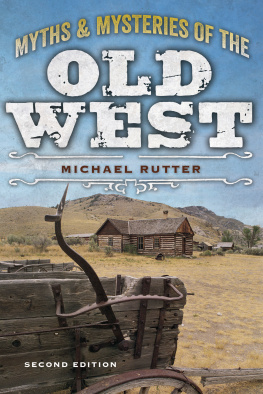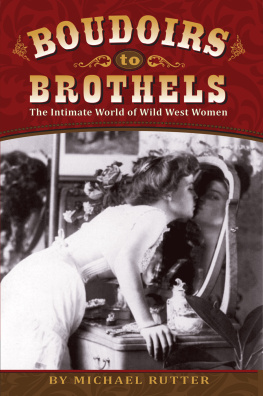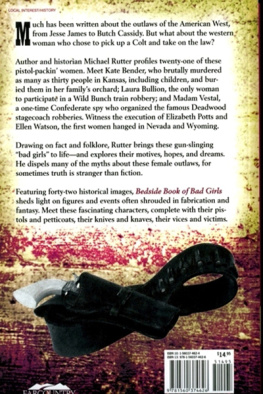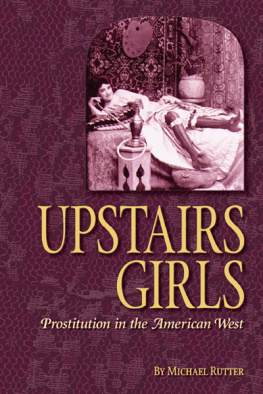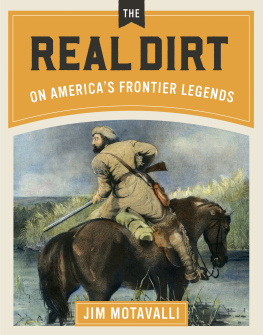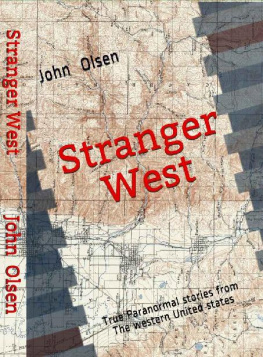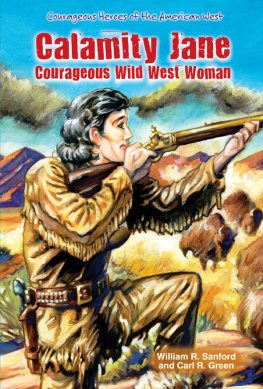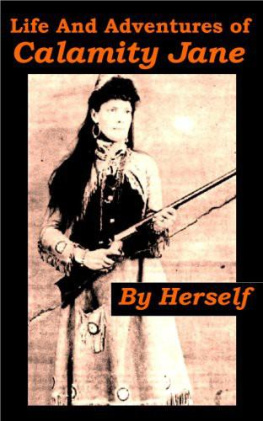Michael Rutter - Myths and Mysteries of the Old West
Here you can read online Michael Rutter - Myths and Mysteries of the Old West full text of the book (entire story) in english for free. Download pdf and epub, get meaning, cover and reviews about this ebook. year: 2017, publisher: TwoDot, genre: History. Description of the work, (preface) as well as reviews are available. Best literature library LitArk.com created for fans of good reading and offers a wide selection of genres:
Romance novel
Science fiction
Adventure
Detective
Science
History
Home and family
Prose
Art
Politics
Computer
Non-fiction
Religion
Business
Children
Humor
Choose a favorite category and find really read worthwhile books. Enjoy immersion in the world of imagination, feel the emotions of the characters or learn something new for yourself, make an fascinating discovery.
- Book:Myths and Mysteries of the Old West
- Author:
- Publisher:TwoDot
- Genre:
- Year:2017
- Rating:5 / 5
- Favourites:Add to favourites
- Your mark:
- 100
- 1
- 2
- 3
- 4
- 5
Myths and Mysteries of the Old West: summary, description and annotation
We offer to read an annotation, description, summary or preface (depends on what the author of the book "Myths and Mysteries of the Old West" wrote himself). If you haven't found the necessary information about the book — write in the comments, we will try to find it.
How much of what we know about the history of the Old West is true? In this new book, author Michael Rutter looks at the legend and lore behind such notorious figures as Billy the Kid and Calamity Jane and the stories of famous gun fights and battles, telling what really happened. Truth may be stranger than fiction, but these 12 legends stand up to scrutiny, and this book will be a must-read for all western history buffs.
Myths and Mysteries of the Old West — read online for free the complete book (whole text) full work
Below is the text of the book, divided by pages. System saving the place of the last page read, allows you to conveniently read the book "Myths and Mysteries of the Old West" online for free, without having to search again every time where you left off. Put a bookmark, and you can go to the page where you finished reading at any time.
Font size:
Interval:
Bookmark:
Myths and Mysteries of the Old West
Myths and Mysteries of the Old West
Second Edition
Michael Rutter
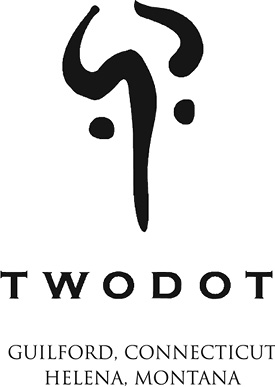

An imprint of Globe Pequot
An imprint and registered trademark of Rowman & Littlefield
Distributed by NATIONAL BOOK NETWORK
Copyright 2017 by Michael Rutter
All rights reserved . No part of this book may be reproduced in any form or by any electronic or mechanical means, including information storage and retrieval systems, without written permission from the publisher, except by a reviewer who may quote passages in a review.
British Library Cataloguing in Publication Information Available
Library of Congress Cataloging-in-Publication Data
ISBN 978-1-4930-2828-3 (hardcover/paperback)
ISBN 978-1-4930-2829-0 (e-book)
 The paper used in this publication meets the minimum requirements of American National Standard for Information SciencesPermanence of Paper for Printed Library Materials, ANSI/NISO Z39.48-1992.
The paper used in this publication meets the minimum requirements of American National Standard for Information SciencesPermanence of Paper for Printed Library Materials, ANSI/NISO Z39.48-1992.
Printed in the United States of America
Thanks to Gary Frazier
Introduction
T he Frontier West seemed endless, a land of adventure and opportunity. While dangerous and unforgiving, it was a rich country for a land-starved people. Hardworking men and women could make their mark in a world that typically didnt favor the commoner. Because the land was so large and foreboding, the men and women who rose to meet its Herculean challenges often loomed larger than life. Instrumental in forging and taming the West, such folk were not only an important part of our young countrys emerging identity, they were a source of national pride. This nation valued and celebrated its heroic ancestry. We were proud that hard work, not birthright, determined a persons success. We were also a storytelling people, taking pleasure in tales about ordinary men and women who took on large challenges. The folklore of the West is as much a part of our heritage as the rugged landscape itself. Indeed the mythology that grew up around the facts often shaped public perception more than the truth.
The California Gold Rush, for example, helped define an emerging nation. Its beginnings were humblemen digging a trench for a sawmill. The strike held promise, but that wasnt enough. The gold fields of the Far West were sold to the American populace in one of the best public relations campaigns of the century. The result was a cross-continental rush for an elusive El Dorado . Fortunes were made on the western slopes of the Sierras, but the real treasure was the richness of the land. However, this wasnt the first time gold fever had struck. The legend of the Lost Seven Cities of Gold fueled the imagination of the Spanish conquerors several centuries earlier. The tall tales of a lazy priest, who told his superior that hed seen the cities so he wouldnt be chastised, launched Coronado on his famous quest for fabulous fortune.
Continuing the quest for fortune in the West were the mountain men who probed its streams and rivers in the hunt for fur. Without doubt one of the greatest mountain men in our bounteous cultural legacy was John Colter. Here was a simple Kentucky lad, a backwoodsman, recruited by Lewis and Clark for one of the most famous expeditions in history. He couldnt get enough of the wonderful new land he helped explore, so he returned as a trapper. His escape from the Blackfeet is legendary. His bravery had been toasted and his exploits retold around many campfires long before any of the stories were written. He has also been credited, mistakenly, for discovering the Yellowstone National Park region that was later given the nickname Colters Hell.
Foxs Police Gazette , Beadles dime novels, and casually written newspaper accounts, fueled by the publics desire to know about the West, made romantic folk heroes or villains out of Jesse James, Billy the Kid, Butch Cassidy, the Sundance Kid, Wild Bill Hickok, George Custer, Calamity Jane, and Buffalo Bill Cody, among others. Some like Wild Bill Hickok and George Custer had a genius for self-promotion, as well as a gift for telling an excellent storynever mind that they played fast and loose with the facts. They understood the power of the press and used it to their advantage. They were held up to the public as paragons of virtue. Surprisingly Hickok, who was often portrayed as the man in the white hat, had more blood on his hands than Billy the Kid. He was deadly with his Colts, even if he wasnt a quick draw as one reads in dime novels. Nor did Wild Bill kill a hundred men as he had reportedly braggedthe number might be closer to seven or eight. And while Custer is known as a bold Indian fighter, he put his military career on the line and argued for better treatment for Native Americans on reservations. At one time Custers reputation was nearing sainthood. Now his status is at an all-time low. He wasnt a saint, but he wasnt the bad guy we often think he was either.
Calamity Janes reputation was also made by pulp fiction and dime novels. She was undoubtedly a brave woman and good with livestock, but she had a weakness for strong drink and that was her undoing. She was a tart, a braggart, and a blowhard. She might have had a successful career in Wild West shows, but she couldnt keep her bottleor her mouthcorked. Nearly everyone she worked for, including Buffalo Bill, had to fire her for drunkenness. She tried to make it in a mans world, and, at least in legend, she succeeded.
Butch Cassidy, the Sundance Kid, and Etta Place naturally shied away from any sort of notoriety. Their reputations as Robin Hood outlaws developed first from the oral tradition, not self-promotion. As benevolent bandits, they cultivated the good will of the common people and were among the most successful thieves in the American West. Incidentally, there is no record of Butch or Sundance shooting anyone. Some very serious scholars argue that Butch and Sundance were shot to death or that their death was a murder-suicide in the face of overwhelming odds. These suppositions are very convincing; however, the romantic in us still hopes the two outlaw heroes lived to a ripe old age in the United States. And what happened to their charming consort, Etta Place? No one is really sure, but some say she was still living with Sundance in Mexico City a dozen years after his reported death in Bolivia.
Others like Billy the Kid, who didnt have much public relations savvy, were victimized as cold-blooded killers and outlaws by the press. Billys biggest mistake was picking the wrong side in the Lincoln County War. He became the scapegoat for all the bloody violence in the region, but in truth he was merely a pawn in a larger power struggle. He wasnt the deadly left-handed killer of twenty-one men as we learn in traditional folklore. Besides being right-handed, he was a likeable young man who enjoyed singing, dancing, and gambling. He killed a couple of men, but he felt it was self-defense. Kid Curry, on the other hand, was a cold-blooded killer who was a true quick-draw in the Hollywood sense, both fast and accurate with his deadly Colt. Many historians argue that he was the most deadly, if not one of the fastest, guns in the West. At one time he was the most wanted man in the United States. He was a member of the Wild Bunch, and Butch Cassidy was the only man who could control him. Still, he had a gentle side not often seenand a passion for fancy French underwear.
Sitting Bull became the whipping boy for the countrys accumulated frustrations after the Little Bighorn. Some thought it impossible that an uneducated savage could defeat one of West Points finest. Others wrote that he must have attended the Point incognito where hed learned military tactics, which explained how he outwitted the US Army. Or, could this heathen prodigy have been trained in Europe before returning to his humble tribe? While such legends are amusing, the real truth about Sitting Bull, a great patriot chief, is of more interest. In his youth, he had more than sixty coups (war honors, often gained by striking a personal blow against an enemy). By the time of the great battle, he was considered a holy man and was known for his visions of the future. He had foretold the coming of the troops. His participation in the battle was mostly spiritual; he let younger chiefs, like Crazy Horse, lead the braves. While the Seventh Cavalry was wiped out, a number of the troopers horses survived, including Comanche, perhaps the most famous cavalry mount in American history. This brave horse was badly wounded in the battle, but he recovered and became the regimental mascot.
Next pageFont size:
Interval:
Bookmark:
Similar books «Myths and Mysteries of the Old West»
Look at similar books to Myths and Mysteries of the Old West. We have selected literature similar in name and meaning in the hope of providing readers with more options to find new, interesting, not yet read works.
Discussion, reviews of the book Myths and Mysteries of the Old West and just readers' own opinions. Leave your comments, write what you think about the work, its meaning or the main characters. Specify what exactly you liked and what you didn't like, and why you think so.

